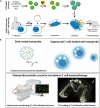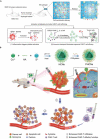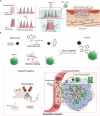Recent Advancements in Biomaterials for Chimeric Antigen Receptor T Cell Immunotherapy
- PMID: 39011521
- PMCID: PMC11246982
- DOI: 10.34133/bmr.0045
Recent Advancements in Biomaterials for Chimeric Antigen Receptor T Cell Immunotherapy
Abstract
Cellular immunotherapy is an innovative cancer treatment method that utilizes the patient's own immune system to combat tumor cells effectively. Currently, the mainstream therapeutic approaches include chimeric antigen receptor T cell (CAR-T) therapy, T cell receptor gene-modified T cell therapy and chimeric antigen receptor natural killer-cell therapy with CAR-T therapy mostly advanced. Nonetheless, the conventional manufacturing process of this therapy has shortcomings in each step that call for improvement. Marked efforts have been invested for its enhancement while notable progresses achieved in the realm of biomaterials application. With CAR-T therapy as a prime example, the aim of this review is to comprehensively discuss the various biomaterials used in cell immunotherapy, their roles in regulating immune cells, and their potential for breakthroughs in cancer treatment from gene transduction to efficacy enhancement. This article additionally addressed widely adopted animal models for efficacy evaluating.
Copyright © 2024 Gaoyu Yu et al.
Conflict of interest statement
Competing interests: The authors declare that they have no competing interests.
Figures






Similar articles
-
The Role of Immunological Synapse in Predicting the Efficacy of Chimeric Antigen Receptor (CAR) Immunotherapy.Cell Commun Signal. 2020 Aug 25;18(1):134. doi: 10.1186/s12964-020-00617-7. Cell Commun Signal. 2020. PMID: 32843053 Free PMC article. Review.
-
The Progress and Prospects of Immune Cell Therapy for the Treatment of Cancer.Cell Transplant. 2024 Jan-Dec;33:9636897241231892. doi: 10.1177/09636897241231892. Cell Transplant. 2024. PMID: 38433349 Free PMC article. Review.
-
Biomaterials for chimeric antigen receptor T cell engineering.Acta Biomater. 2023 Aug;166:1-13. doi: 10.1016/j.actbio.2023.04.043. Epub 2023 May 2. Acta Biomater. 2023. PMID: 37137403 Review.
-
Biomaterials promote in vivo generation and immunotherapy of CAR-T cells.Front Immunol. 2023 Apr 20;14:1165576. doi: 10.3389/fimmu.2023.1165576. eCollection 2023. Front Immunol. 2023. PMID: 37153571 Free PMC article. Review.
-
Biomaterials in Chimeric Antigen Receptor T-Cell Process Development.Acc Chem Res. 2020 Sep 15;53(9):1724-1738. doi: 10.1021/acs.accounts.0c00335. Epub 2020 Aug 6. Acc Chem Res. 2020. PMID: 32786336
References
Publication types
LinkOut - more resources
Full Text Sources
Miscellaneous

